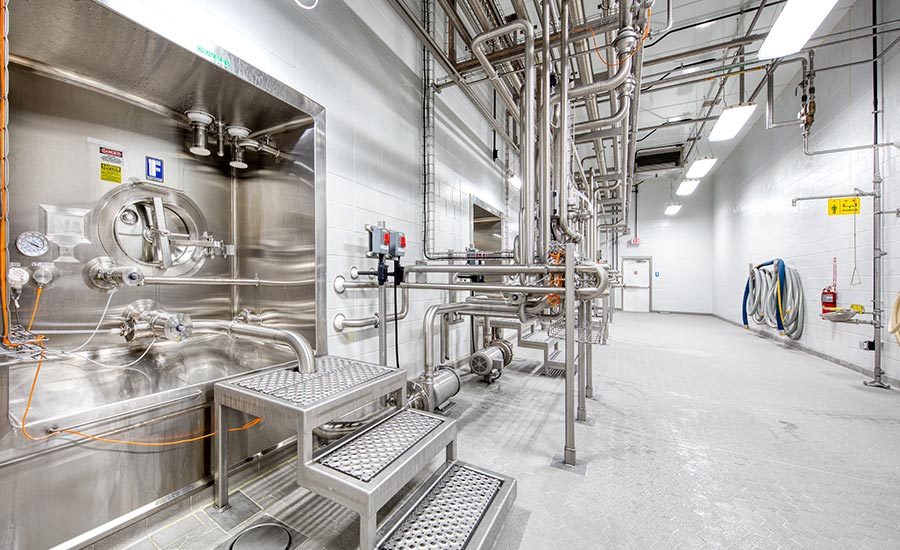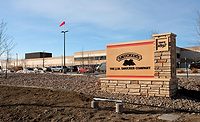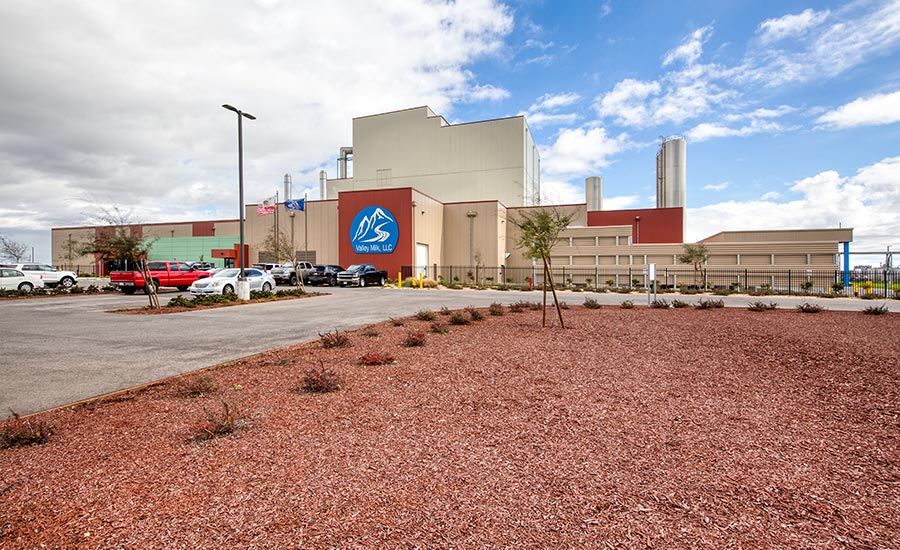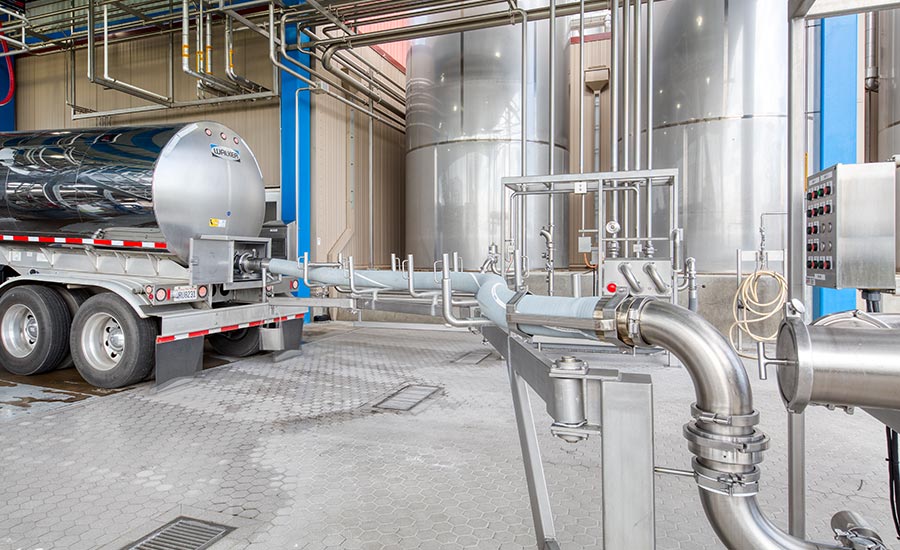Plant of the Year
Plant of the Year 2019: Valley Milk's new facility aids vertical integration
Milk processor pushes the envelope at every opportunity, earns Food Engineering award

Valley Milk LLC, a Turlock, Calif.-based milk powder processor, has been named the 2019 Food Engineering Plant of the Year. The facility pushes the envelope in every possible area while complying with California energy, water and seismic standards.
All photos courtesy of Daniel Blue Photography

Instead of three unloading bays with 3-inch hoses, the facility uses two unloading bays with a 6-inch hose. Because the hose is too heavy for one person to attach, detach and move easily, Shambaugh & Son designed a swing arm that allows one operator to position the hose and keeps it off the ground without typically used supports.

The two bays allow the facility to unload 50 tankers every 24 hours. The tankers come from the 16 dairies owned by Valley Milk’s founding families, all within 40 miles of the facility.

Equipment in the plant is anchored to stainless steel plates attached to the floor. Because the equipment isn’t directly attached to the floor, the space allows for water to flow freely instead of ponding.

Utility lines throughout the plant are run inside pipes that extend through a walkable ceiling, keeping the horizontal surfaces out of process areas. Utilities drop down to the point of use, eliminating potential areas for material to build up.

Stairs and platforms throughout the plant are designed with stand-offs to eliminate long continuous welds or sealant joints. Stair treads allow washdown water to flow freely.






Click here to see the 2020 Plant of the Year winner!
Valley Milk didn’t start as an idea—it started as a big idea.
A collaboration among several dairy families and nutritionists in California’s Central Valley, the company came together several years ago as a way to go beyond selling milk. The families already knew how to do that.
Article Index:
What they wanted was to be more than milk producers. Instead, they wanted to be vertically integrated to manufacture a sustainable dairy ingredient. As multigenerational dairy families, they wanted a way to ensure their legacies for the long term. The best way to do that was to grow into an operation that wouldn’t rely on others to buy their milk and would give them more control over their own destinies.
“What really was the driving factor for this group of founders was to make sure that we have a long-term home for our milk and be able to be vertically integrated and have control over the entire process,” says Valley Milk CEO Patti Smith. “Basically saying, ‘Why supply other processors? We’ll do this ourselves.’”
The idea was an expansive one, to be sure. The families had the capability to deliver the milk from 16 dairies within an hour drive of Turlock, Calif., but if they were going to start processing it themselves, they would need a plant to send it to. And if they were going to build something that was meant to define a legacy beyond meeting basic business needs, not just any plant would do.
It would have to be energy efficient; automated; capable of providing water to meet process needs, lessening demand on the municipality; compliant with California seismic standards; and able to process 2.5 million pounds of milk from 50 tanker deliveries every day into milk powder and liquid cream.
Oh, and on time and on budget would be nice too, even if construction ran headlong into one of the rainiest years on record.
Valley Milk turned to Shambaugh & Son L.P., an EMCOR Group Inc. subsidiary, to help make its big idea into reality. The two companies nailed every one of those goals, and consider this: They did it without a single change order during the entire process. That would be an impressive accomplishment for any construction project. But as you dig into the particulars of the Valley Milk facility, it becomes an almost staggering feat.
This is a legacy project, in the most forward-looking sense of the term. And what a legacy it is.
History and legacy
Since 1899, dairies have been a staple of the Central Valley agricultural economy. The region is known as some of the most fertile growing ground in the entire world, and the milk produced from dairies there helps California make more milk than any other state, by a wide margin.
But milk is tricky as an ingredient. Cattle produce on a schedule that doesn’t offer much flexibility, and milk has to be processed pretty quickly. To put it simply, dairies need to be near the milk’s final destination, which means that where you find dairies, you find companies that use milk.
Valley Milk by the numbers
Volume:
2.5 million pounds per day milk processing capability, with design to increase to 3.2 million pounds per day
Products produced:
Instantized agglomerated skim milk powder, nonfat dry milk powder, whole milk powder, agglomerated whole milk powder, liquid cream
Milk tankers unloaded:
50 per 24-hour period
Raw milk storage capacity:
1.785 million pounds (210,000 gallons)
Process water storage capacity:
120,000 gallons
Pasteurized cream storage capacity:
60,000 gallons
Cold milk separation capacity:
62,500 pounds per hour
Cream pasteurization capacity:
11,000 pounds per hour
For that same reason, dairies tend to cluster together. If the dairy doesn’t have its own hauling operation, then it’s probably—depending on its size—sharing a hauler with another dairy or more. That means the logistics get complicated, because haulers need to pick up milk from several dairies and deliver it while it’s fresh. Pickups have to be scheduled with producers, and deliveries have to be scheduled with processors.
The process involves a lot of moving parts, and all it takes is for one of them to get out of whack to throw everything off. So when Valley Milk’s founding families, along with nutritionists and veterinarians who are also part of the group, started considering vertical integration, one of the biggest attractions was a beginning-to-end solution, Smith says. There are 16 dairies among the families, and providing a destination for their 50 tankers per day would cut down on the number of things that could go wrong.
“They started several years ago thinking about the idea and what it would take to be vertically integrated, especially from the standpoint they were all from multigenerational families,” says Smith. “And they wanted to keep those things in the state of California. And they wanted to be able to actually have a home for the milk long term for generation after generation. So that’s how the idea started.”
With the goal of vertical integration as the endpoint, the next step was deciding how aggressive to be in pursuing a truly cutting-edge facility. The answer? Very.
“The concept was built around true state-of-the-art, leading-edge ideas and technology,” says Smith
Ed Steven, Valley Milk’s plant manager, has been in the industry for more than 40 years. He points out that the plan was not only to meet current needs, but to be able to expand up to 20 percent in the future as demand increases. Beyond simply building around the idea of “we currently do X, one day we hope to do Y,” the project was a chance to dream big, Steven says.
“The biggest thing for me was understanding the vision of the founding families and then translating that into the engineering design, by way of efficiencies, automation technology and knowing what was available in this day and age,” he says. “And to be quite honest, a lot of it is only limited by your imagination.”
Turning the dreams into reality is where Shambaugh & Son, now honored with its fifth Food Engineering Plant of the Year Award, came in. In addition to being a national design-build company, Shambaugh also has the in-house capabilities to fabricate various components of buildings and their process and utility systems.
Piece by piece
Shambaugh & Son’s fabrication capabilities played a large role in the project’s success. One of the best examples is one of the simplest: the hose to unload tankers.
Typical milk tankers unload with 3-inch hoses, but Valley Milk tankers have 6-inch outlets that pair with a 6-inch hose, which is pretty big. It’s big enough, in fact, that one person can’t easily maneuver it into place without slowing the unloading process, about eight minutes per tanker at the fastest. When you’re unloading 50 tankers every day, little delays here and there add up quickly.
That is unless you figure out a way to put the hose on a swing arm.
That’s exactly what Shambaugh did. Bob Keplinger, vice president, national design-build operations, designed a frame robust enough to hold the 6-inch hose and well-balanced and maneuverable so that a single operator could swing it between tankers. It was a solution that Shambaugh had never tried before for a hose of that size, says Patrick Cole, the Valley Milk project program manager. The swing arm also eliminated the need for donuts to keep the hose off the ground to comply with USDA regulations.
“The swing arm supports the hose, so that it pitches to the pump and is completely off the ground at all times to comply with FDA and USDA regulations,” says Cole. “It smoothly swings between tankers and locks in place as trucks enter the bays for unloading.”
Here’s the real advantage: By providing an efficient solution for using a 6-inch hose, Shambaugh was able to eliminate an entire unloading bay from the project. Instead of three bays with 3-inch hoses, the plant has two bays using the 6-inch hose.
Design, build, succeed
While the swing arm is an easy way to visualize the amount of detail that went into the project, it’s just one of a laundry list of examples of Valley Milk’s commitment to a leading-edge facility and Shambaugh & Son’s commitment to delivering that facility. In every part of the plant, in every aspect of the production process, innovations small and large add up to a facility that not only met, but exceeded Valley Milk’s high expectations.
In any facility that works with dry products, dust control is critical for contamination and explosion prevention. Typical steel I-beams have flat surfaces where dust can collect. Shambaugh & Son tackled that challenge by incorporating “clean beams,” which are I-beams made with gusset inserts to provide a slope. That meant more lead time was necessary for the design, fabrication and construction process, says Cole.
“It’s an extra step that happens in the fabrication of the beams,” says Cole. “You’re not buying a standard I-beam anymore; you’re buying an I-beam that is then going to be fabricated.”
The resulting supports for elevated decks and the roof have sloped surfaces at the bottom flanges, preventing dust and powder from collecting there.
In addition to dust control, cleaning and sanitation were top of mind throughout the process. Stair and deck designs traditionally have horizontal surfaces, corners and cracks where material can collect and be hard to clean. Shambaugh designed floating stair treads, landings, access platforms and decks.
The treads include stand-off tabs so they are not joined by continuous welds or sealant joints. The tread sides end short of the stair frame, and two small tabs connect the tread to the frame, leaving room for washdown water to freely drain. The treads also are designed to allow drainage.
Landings, access platforms and decks float above the support structure using 2-inch standoff plates. This allows for ease of cleaning and also eliminates the need for sealant joints in those areas.
To help facilitate cleaning and minimize standing or running water, hub drains are located near process waste discharge points. In wet areas, the floors slope away from high foot traffic areas. Evaporator decks are seal-welded and pitched to drain, and floors are sloped toward drains.
Cleaning and dust control weren’t the only factors that helped shape design decisions. The plant requires an extensive utility infrastructure. To accommodate that, Shambaugh & Son designed a utility corridor, or “utilidor,” to provide utilities throughout the plant while minimizing the amount of horizontal piping in clean spaces. Walkable ceilings were installed above process spaces to keep piping out of those areas. The utility piping runs through the walkable ceiling and, wherever possible, drops directly to its use point.
Seismic regulations
In order to comply with California’s seismic regulations, the facility was basically constructed as four buildings, each with the ability to move 4 inches independently, including the piping.
This was another area that required more upfront work before anything was put together, says Cole.
“The real challenge was timing issues,” he says. “Completing the design in time to get through the strict permitting and regulatory process and still meet the building schedule was a real challenge. Having a 3D model available to review the final design with the owner during the planning phase was a huge benefit.”
Among the specific areas of concern were ceilings, which needed intensive support structures; pipeline transitions between buildings, which required flexible joints; and anchoring for equipment.
Processing equipment was anchored to the vitrified tile floor to accommodate the seismic requirements. Shambaugh embedded stainless steel plates into concrete slabs so that process skids and equipment could be seal-welded to the floorplates. Adding the steel plates also helped avoid ponding of water at the areas where equipment was connected to the floor.
Water challenges
There were two challenges facing the project when it came to water: not enough of it and too much of it.
The first of those had to do with the water needed for the production process. The local water supplies didn’t meet the process specifications, so Shambaugh supplied a reverse osmosis system to remove foreign material from incoming water so that it could be used to clean process equipment.
Shambaugh & Son also supplied a reverse osmosis polisher system to collect water off of the evaporator for reuse. This system provides most of the water in the plant on a daily basis.
The landscaping uses drought-resistant plants and grass to cut down on watering and because drought conditions are common.
But there certainly weren’t drought conditions during most of the construction process. Much of the building took place during the wettest winter the state had seen in more than 100 years, which not only created challenges with construction, but even with getting materials and workers to the site.
“We used a huge amount of rock just to keep the roadways open for the workers coming in and out,” says Cole.
Smith points out that when construction started, it was dry.
“We spent the first three to four months of the project basically putting water on the property,” says Smith, “and then we spent the next six to seven months taking water off because we had too much water.”
Another water-related challenge was the local water table. It was at 10 feet, but the pilings and piers had to be augered deeper than that. So the construction process involved digging well past the water table to anchor everything.
In addition, the local waste water treatment plant required the process water to be treated before it could be discharged into the sewer system. An on-site waste water treatment plant was constructed.
The plant has a 300,000-gallon equalization/aeration tank with aeration blowers. Chemical treatment, pH adjustment systems, DAF and an effluent monitoring system help ensure that the water is pretreated correctly before discharge. Extra surge capacity was designed into the aeration tank, and the system is designed to allow for future expansion without major modifications.
Operations
While the design and build processes were impressive, the plant’s day-to-day operations are where the rubber meets the road. No matter how impressive the facility is, it has to operate well.
In this case, that means processing 2.5 million pounds of milk per day, with the design capability to increase to as much as 3.2 million pounds per day. The products produced include skim milk powder, whole milk powder and liquid cream, among others.
The plant unloads 50 tankers every 24 hours and can store up to 210,000 gallons of raw milk and 60,000 gallons of pasteurized cream. Cold milk can be separated at a rate of 62,500 pounds per hour, while cream is currently processed at 11,000 pounds per hour.
For powders, the dryer system can handle a 22,000-pound-per-hour liquid feed and produce 12,000 pounds per hour of powder. That powder can be packaged in less than 24 hours.
All of this is done through a tightly controlled, highly automated system that allows for rapid, efficient production with a minimal amount of labor. As Steven says, being able to meet production goals without needing major increases in the workforce was one of the primary goals.
“I mean, if you can imagine a piece of equipment that can be controlled and tuned to the extent where in the past you may have needed 120 people to run a facility of this size and manufacturing capability, we want to streamline it from a technology automation standpoint where we minimize the amount of labor that it was going to take to run it,” says Steven.
Steven didn’t just pick 120 people as a random example. He points out that 30 to 40 years ago, it would take about that number of people to operate a plant the same size as the Valley Milk facility. That number is operators only, not even including support staff. But Valley Milk operates the entire facility with about 60 people, support staff included.
Success by every measure
The Valley Milk facility is a remarkable feat of engineering, design, construction and operations. From the beginning stages as an idea for how to ensure a legacy for the company’s founders to its ongoing operations today, the project has hit every one of its goals at every step of the way, even when designing around California’s energy, water and seismic regulations, as well as its fickle weather.
That couldn’t have happened without both a customer and an engineering firm that were on the same page and in constant communication with each other about how to approach challenges, adjust on the fly and stick to the plan even when weather or other issues made it tricky.
And there were challenges, because building a plant is complicated, and building one in California is even more complicated. The extra regulations add layers of complexity and more things that need to be signed off on, and the historic rainfall during construction only increased the degree of difficulty.
But through all that, Valley Milk and Shambaugh & Son stuck to the plan, figured out ways to work around challenges and ended up with a facility that met the founding families’ goal of ensuring not just a quality operation in the short term, but a long-term legacy. They did it with no change orders and no lost-time accidents, finishing ahead of schedule and under budget. That’s an extraordinary achievement under the best of circumstances.
Reflecting on the project, Steven, a longtime veteran of plant operations and construction processes, sums it up simply.
“All things considered, I know I can put my hand on my heart and say from the time we started to the time we had the plant handed over to us, we, as Valley Milk LLC, did not issue one change order for that design, engineering, build and handing over of the plant,” says Steven. “And we actually commissioned and came on production three days earlier than originally scheduled.”
See more Food Plant of the Year content
For more information:
Valley Milk,
www.valleymilkca.com
Shambaugh & Son,
www.shambaugh.com
Looking for a reprint of this article?
From high-res PDFs to custom plaques, order your copy today!













